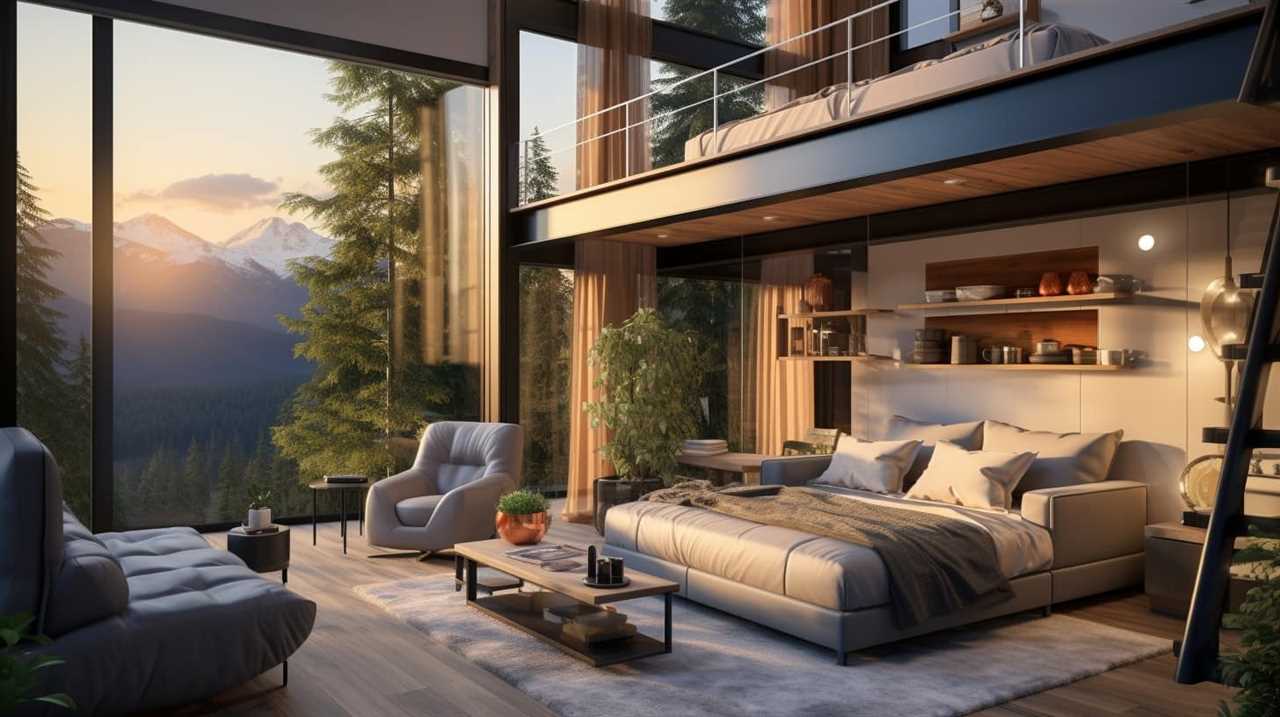Are you prepared to incorporate sustainability and luxury into your tiny house lifestyle? Our expert tips and tricks have everything you need.
In just 10 simple steps, we’ll show you how to create a harmonious blend of eco-friendly practices and high-end features.
From choosing the perfect location to incorporating renewable energy sources, we’ll guide you every step of the way.
Get ready to live large in a small space with our practical and knowledgeable advice.
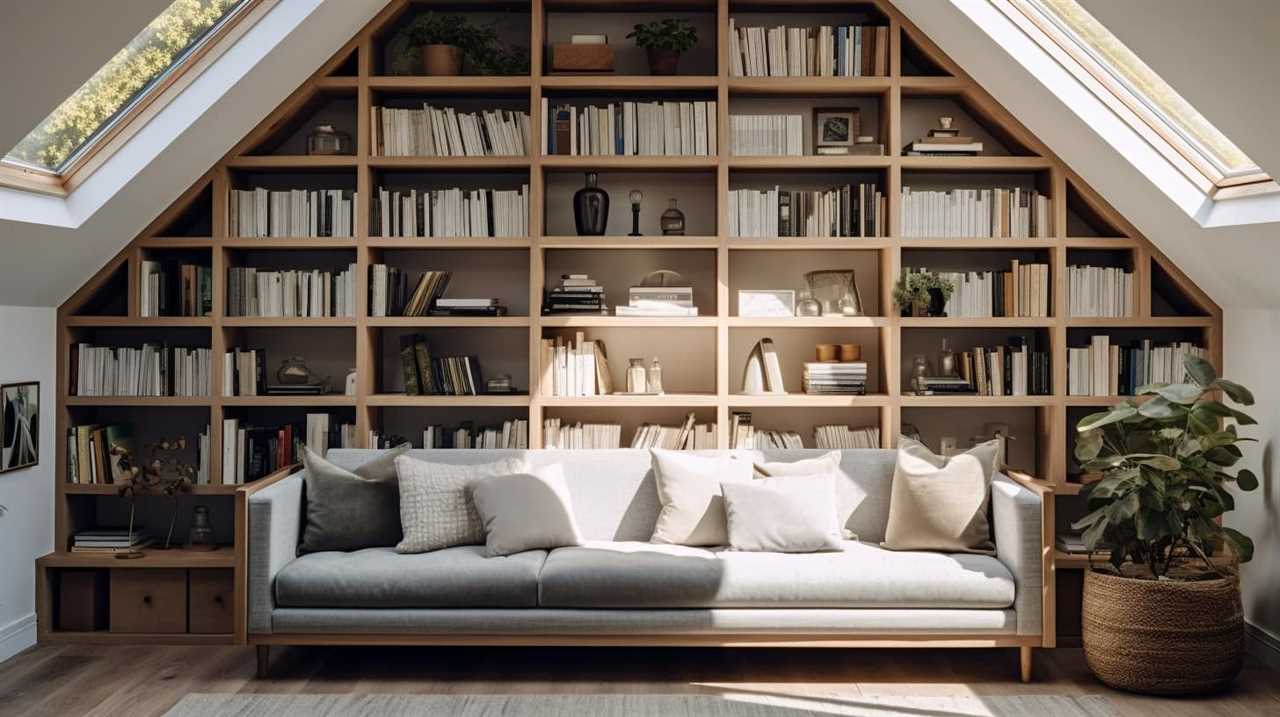
Let’s dive in and make your tiny house dreams a reality.
Key Takeaways
- Conduct thorough research on zoning regulations and consider the environmental impact of the chosen location
- Maximize space and natural light through strategic design choices such as space-saving furniture and strategic window placement
- Choose sustainable building materials like eco-friendly insulation options and reclaimed wood flooring
- Utilize renewable energy sources like solar panels and wind turbines, as well as practice sustainable lifestyle habits like energy and water conservation
Choosing the Right Location for Your Tiny House
When it comes to finding the perfect spot for our tiny house, it’s important to consider our unique needs and preferences.
To ensure a harmonious living experience, we need to conduct thorough research on zoning regulations. This step is crucial as it helps us understand if our tiny house is allowed in the desired location and if there are any restrictions or requirements we need to comply with.
Additionally, we must consider the environmental impact of our chosen location. By selecting a site that aligns with our sustainability goals, we can minimize our carbon footprint and contribute to the preservation of the environment. Evaluating factors such as access to renewable energy sources, water conservation methods, and waste management options will enable us to create a sustainable and eco-friendly lifestyle in our tiny house.
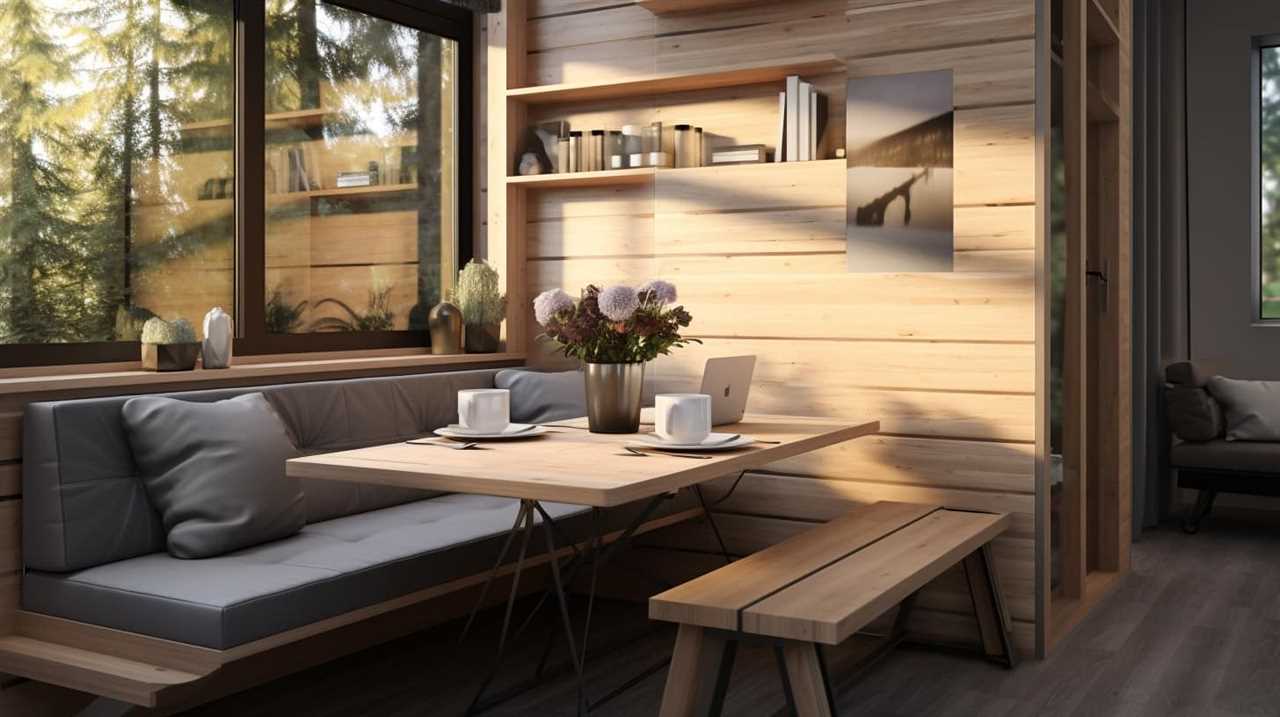
Designing an Efficient and Functional Floor Plan
When it comes to designing an efficient and functional floor plan for a tiny house, there are several key points to consider.
First, space-saving furniture options can make a big difference in maximizing the available square footage.
Secondly, maximizing natural light through strategic window placement can create a more open and spacious feel.
Lastly, incorporating multi-purpose room layouts can help make the most of every inch of space in the tiny house.
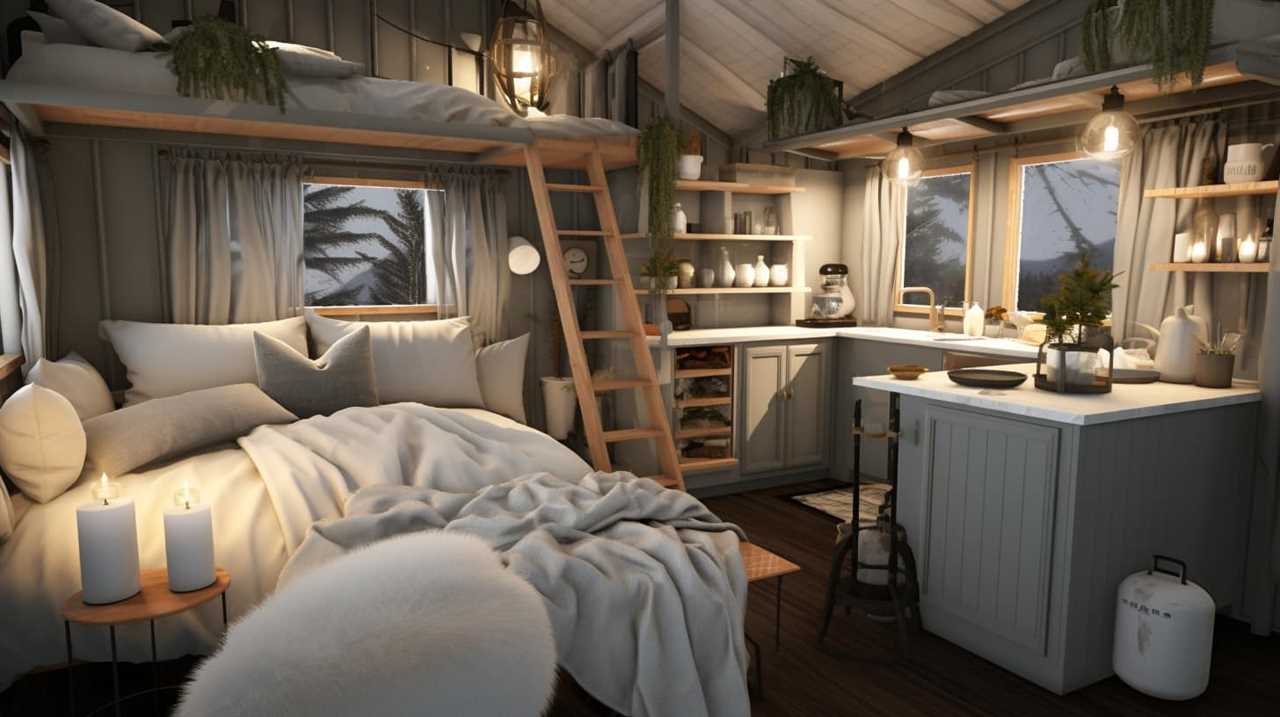
Space-Saving Furniture Options
We can maximize our use of space by incorporating multifunctional furniture options into our tiny house floor plan. Space saving furniture options and innovative storage solutions are essential for creating an efficient and functional living space.
One popular option is a sofa that can be transformed into a bed, providing a comfortable place to sit during the day and a cozy sleeping area at night.
Another great idea is to use floating shelves and wall-mounted storage units to free up valuable floor space.
Additionally, consider investing in furniture with built-in storage compartments, such as ottomans with hidden storage or coffee tables with drawers. These clever solutions allow you to make the most of every inch in your tiny house while still maintaining a stylish and luxurious living environment.
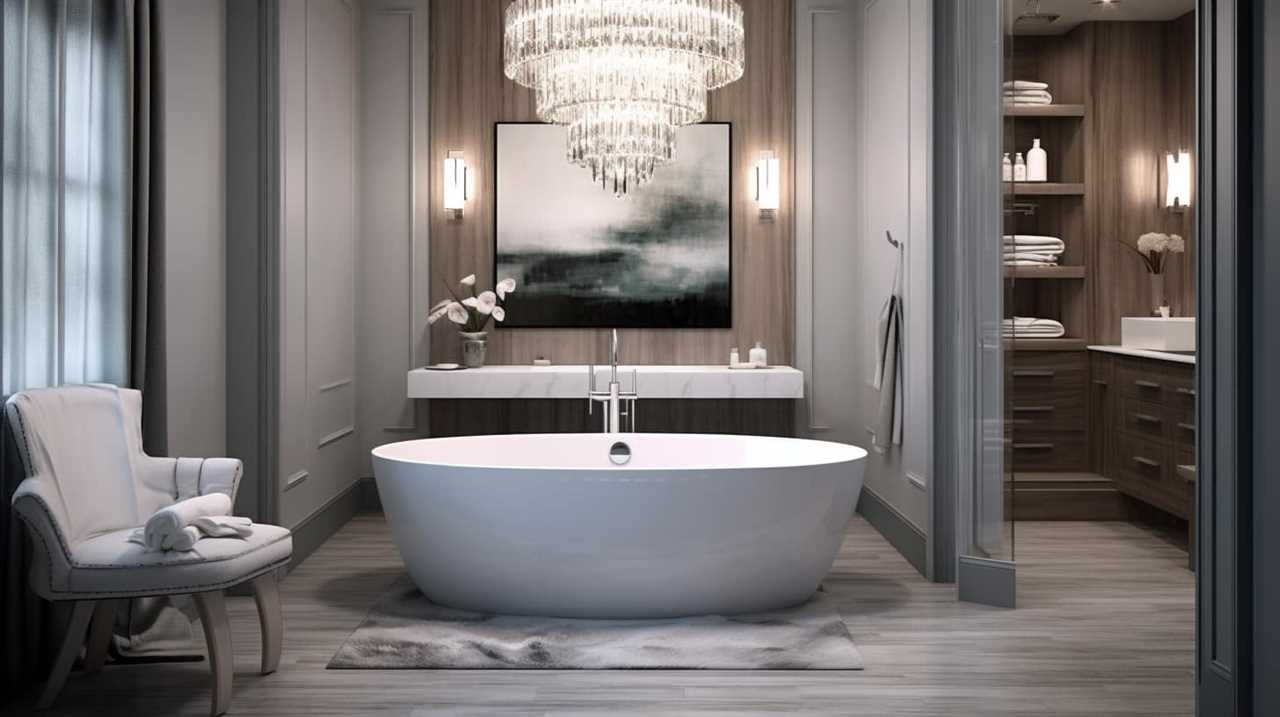
Maximizing Natural Light
To optimize natural light in our tiny house, we can strategically position windows and skylights throughout the floor plan. By doing so, we can reap the benefits of natural light, such as improved mood, reduced energy consumption, and a sense of openness.
Here are some practical ways to maximize sunlight in your tiny house:
- Choose larger windows: Opt for windows that are larger in size to allow more natural light to enter your space.
- Utilize skylights: Install skylights in areas where windows may not be feasible, like bathrooms or stairwells.
- Consider window placement: Position windows in areas that receive the most sunlight throughout the day, such as south-facing walls.
Maximizing natural light not only enhances the aesthetic appeal of your tiny house but also creates a healthier and more sustainable living environment.
Now, let’s explore how multi-purpose room layouts can further optimize the functionality of your tiny house.
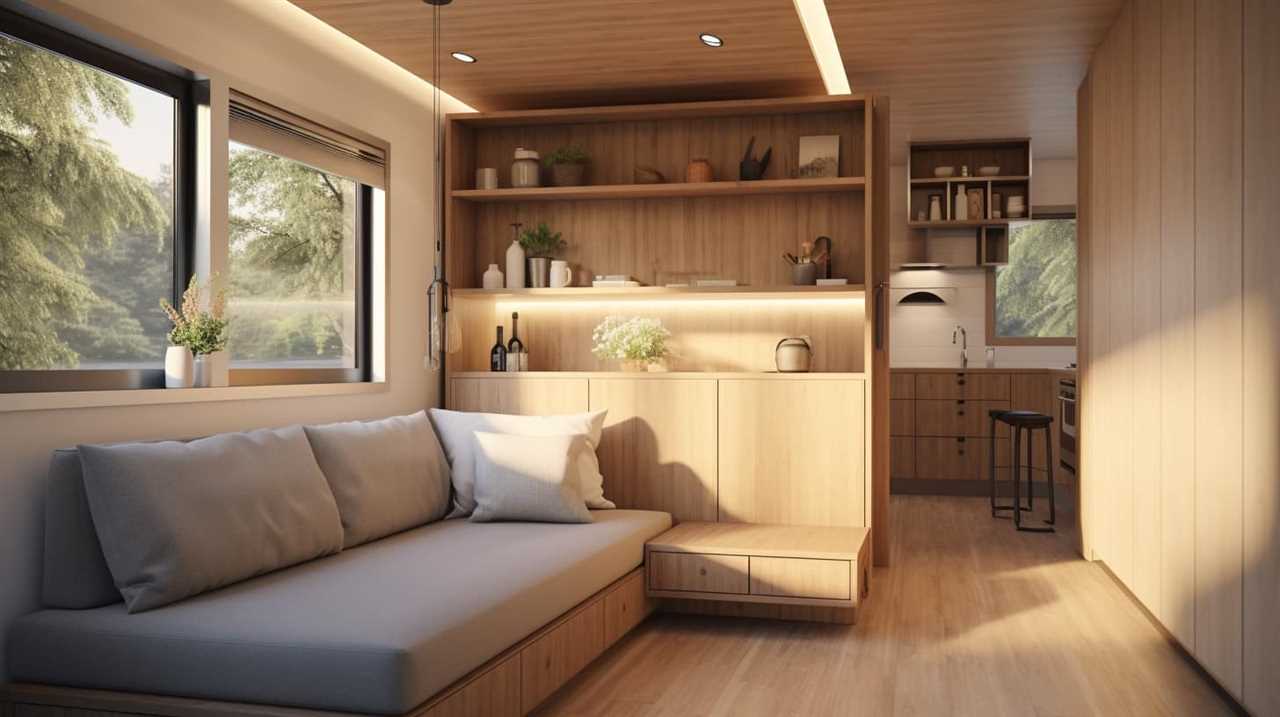
Multi-Purpose Room Layouts
Our goal is to create a multi-purpose room layout that maximizes efficiency and functionality in our tiny house.
To achieve this, we need to carefully consider the use of space and incorporate multi functional furniture and creative storage solutions.
One idea is to use a fold-down dining table that can be easily tucked away when not in use, creating extra room for activities.
Another option is to utilize built-in shelving and hidden compartments to maximize storage space without sacrificing style.
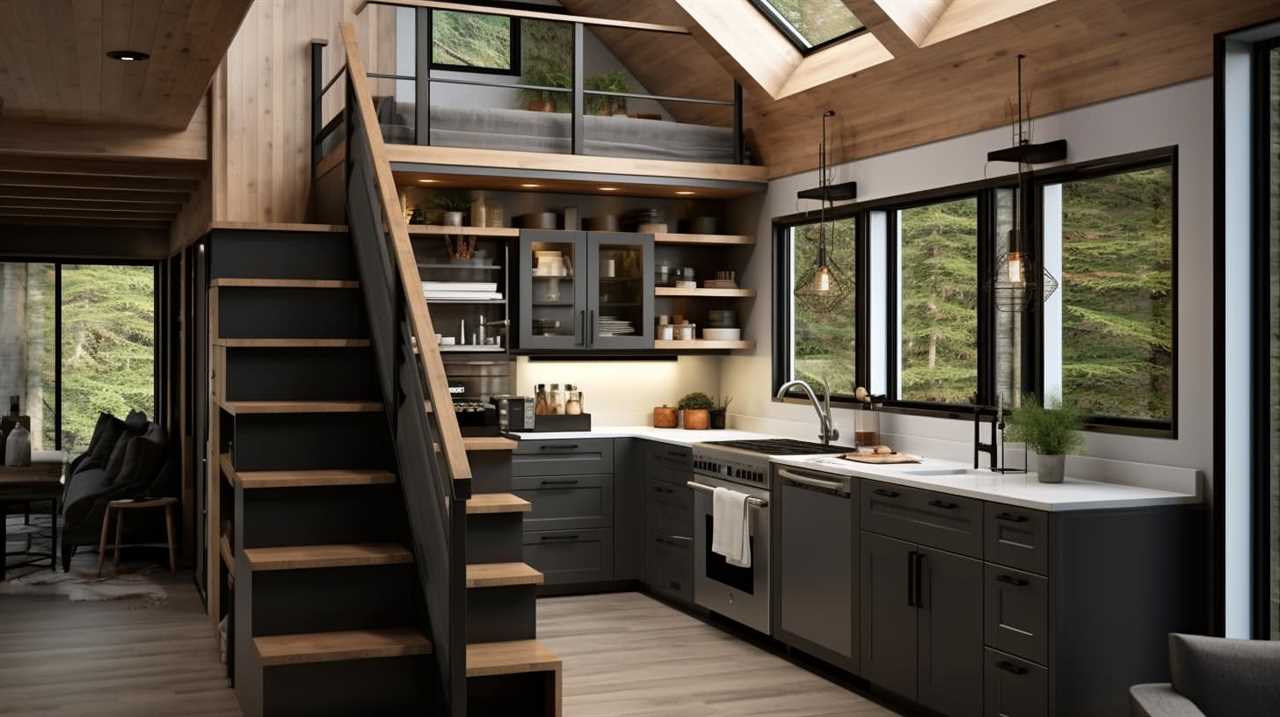
We can also consider using modular furniture that can be rearranged to serve different purposes, such as a sofa that can transform into a bed.
Incorporating Sustainable Building Materials
When it comes to incorporating sustainable building materials into our tiny house, we’ve several choices that are both eco-friendly and cost-effective.
Choosing materials such as reclaimed wood, recycled metal, and bamboo flooring not only reduces our environmental impact but also adds a unique and luxurious touch to our living space.
Eco-Friendly Material Choices
We can make eco-friendly material choices by incorporating sustainable building materials in our tiny house construction. By doing so, we not only reduce our environmental impact but also create a healthier and more energy-efficient living space. Here are some options to consider:
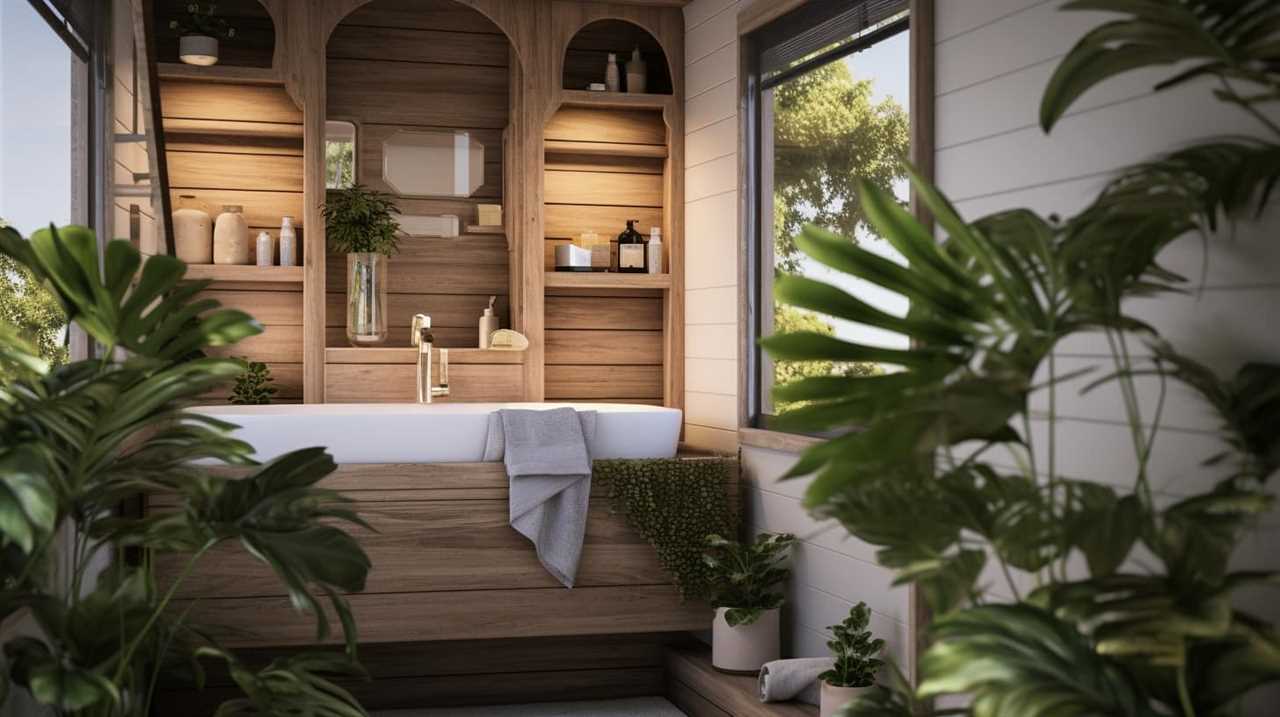
-
Eco-friendly insulation options:
-
Recycled denim: Made from post-consumer denim waste, this insulation material is non-toxic and provides excellent thermal performance.
-
Cellulose insulation: Made from recycled paper, this material is treated with non-toxic borate to resist pests and fire.
-
Wool insulation: A natural and renewable option, wool insulation is biodegradable and has excellent insulation properties.
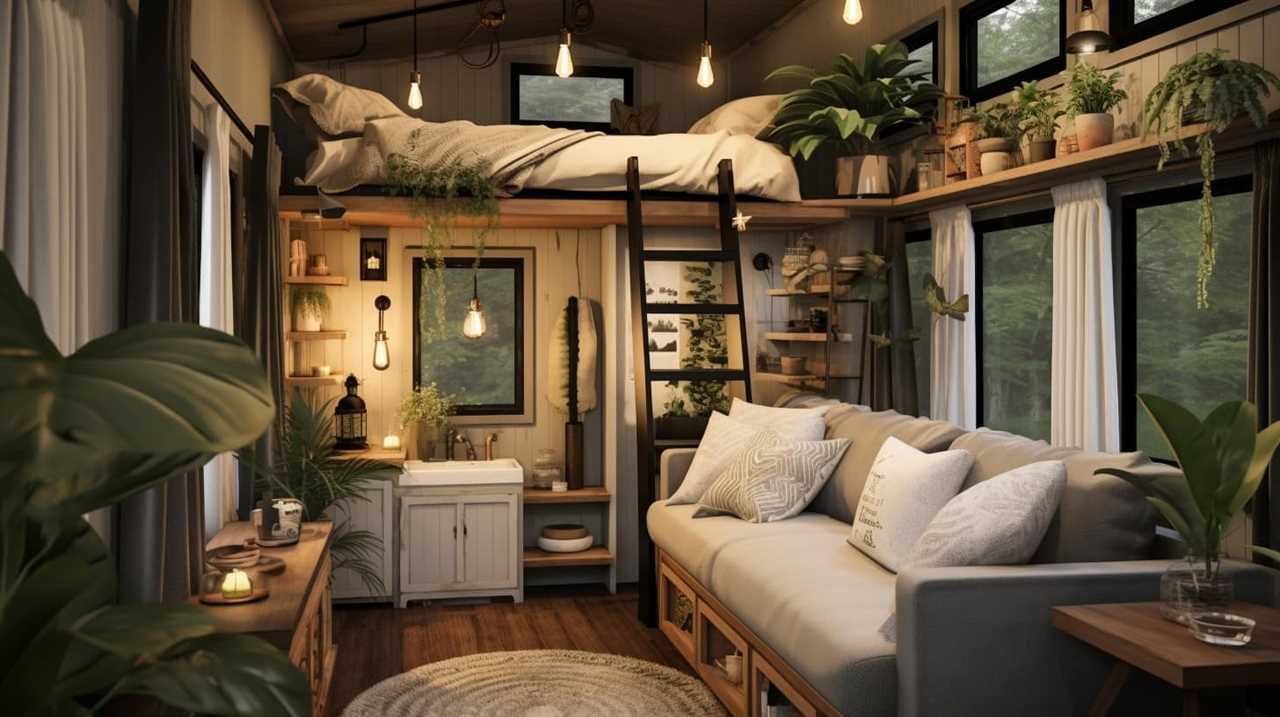
-
Sustainable roofing materials:
-
Metal roofing: Durable and recyclable, metal roofs can last for several decades and reflect sunlight to reduce cooling needs.
-
Recycled shingles: Made from recycled materials such as rubber or plastic, these shingles offer durability and eco-friendliness.
-
Living roofs: By incorporating vegetation, these roofs provide insulation, improve air quality, and absorb rainwater.

Benefits of Sustainable Materials
One of the key benefits of incorporating sustainable building materials is that they can significantly reduce our carbon footprint. When it comes to sustainable materials in interior design, using eco-friendly materials offers numerous advantages.
Firstly, these materials are sourced and manufactured in a way that minimizes harm to the environment. By using renewable resources, such as bamboo or reclaimed wood, we can help conserve forests and reduce deforestation.
Additionally, eco-friendly materials often have lower levels of harmful chemicals, improving indoor air quality and promoting a healthier living environment.
Moreover, these materials are often more durable and long-lasting, reducing the need for frequent replacements and minimizing waste.
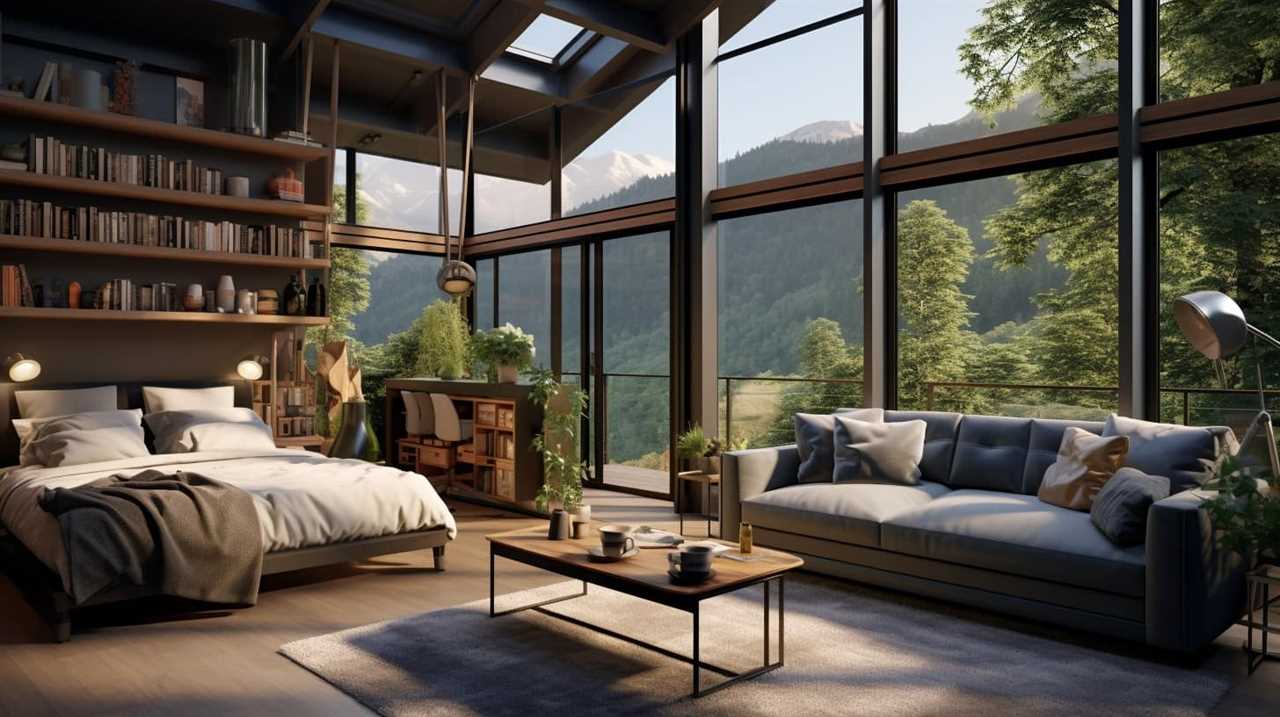
Cost-Effective Green Options
With careful planning and research, we can incorporate cost-effective green options and sustainable building materials into our tiny house design. By doing so, we not only contribute to low budget sustainability but also create an environmentally friendly living space.
Here are some key options to consider:
-
Recycled materials: Utilizing salvaged and repurposed materials can significantly reduce costs while promoting sustainability.
-
Energy-efficient appliances: Opting for energy-efficient appliances can help reduce energy consumption and lower utility bills.
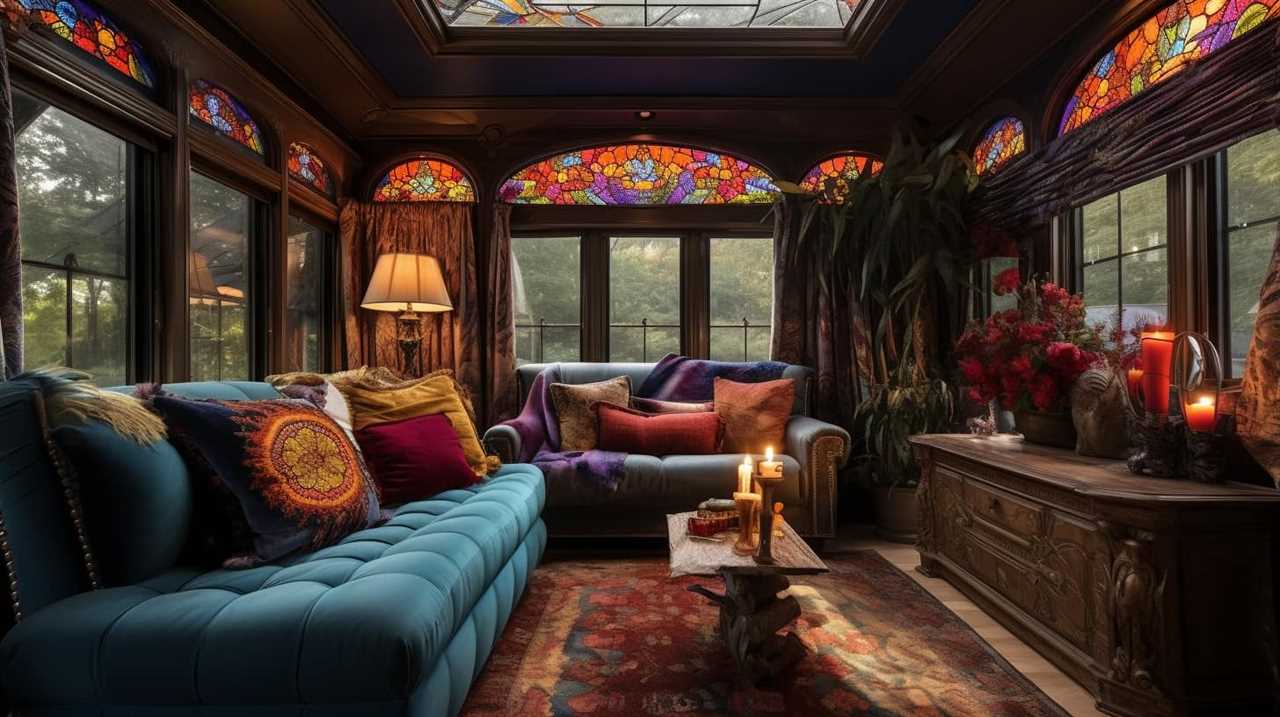
-
Solar panels: Installing solar panels can provide a sustainable and cost-effective source of energy for your tiny house.
-
Sustainable transportation options: Consider incorporating bike racks or electric vehicle charging stations into your design, encouraging eco-friendly transportation choices.
Harnessing Renewable Energy Sources
Solar panels are an excellent solution for harnessing renewable energy sources in our tiny house. By utilizing the power of the sun, we can reduce our carbon footprint and take advantage of the numerous benefits of renewable energy. Solar panels not only provide a clean and sustainable source of electricity but also help us save money on energy bills in the long run. Additionally, they require minimal maintenance and have a long lifespan, making them a practical choice for tiny house living.
To further highlight the advantages of renewable energy technologies, here is a table showcasing some of the key benefits:
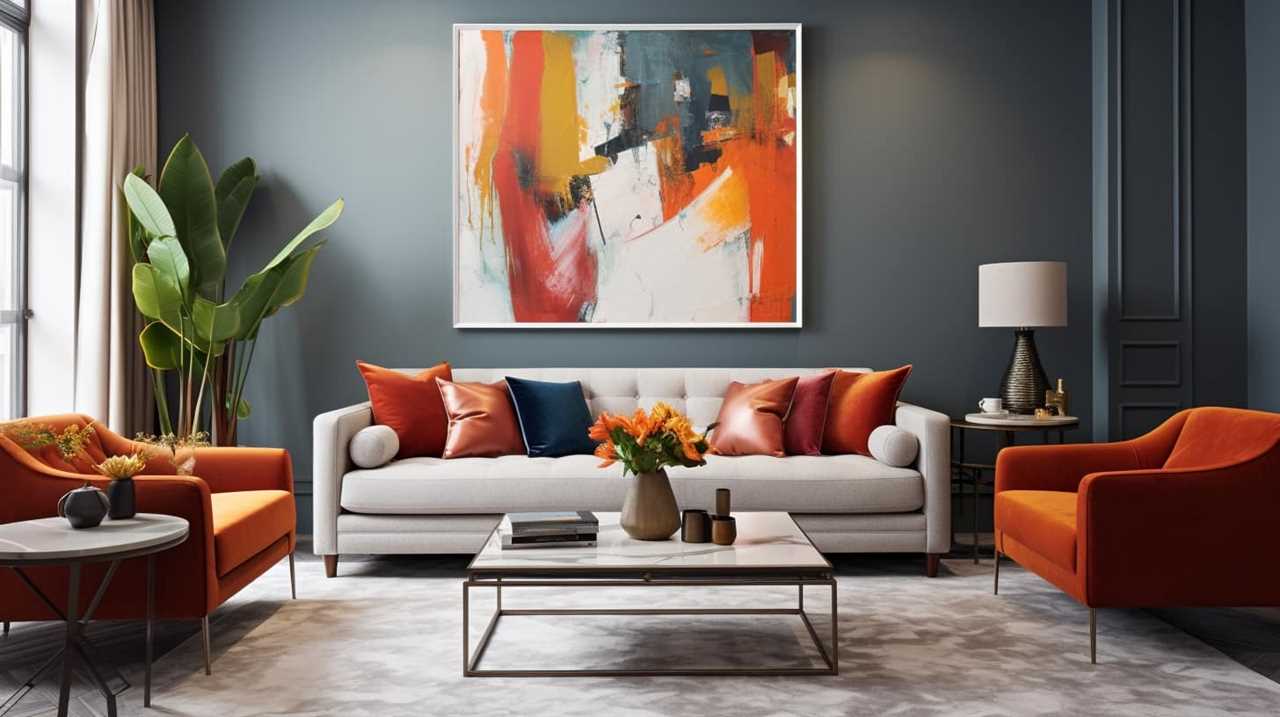
| Benefits | Renewable Energy Technologies |
|---|---|
| Clean and sustainable | Solar power, wind energy |
| Reduced energy costs | Solar power, geothermal heat |
| Minimal maintenance | Solar power, hydroelectricity |
| Long lifespan | Solar power, biomass energy |
Harnessing renewable energy sources not only allows us to live sustainably but also ensures a more luxurious and cost-effective lifestyle in our tiny house.
Implementing Water Conservation Strategies
When it comes to implementing water conservation strategies in tiny house living, there are several key points to consider.
First, investing in efficient fixtures and appliances can significantly reduce water usage without sacrificing comfort.
Second, incorporating rainwater harvesting systems allows for the collection and reuse of rainwater for various purposes.
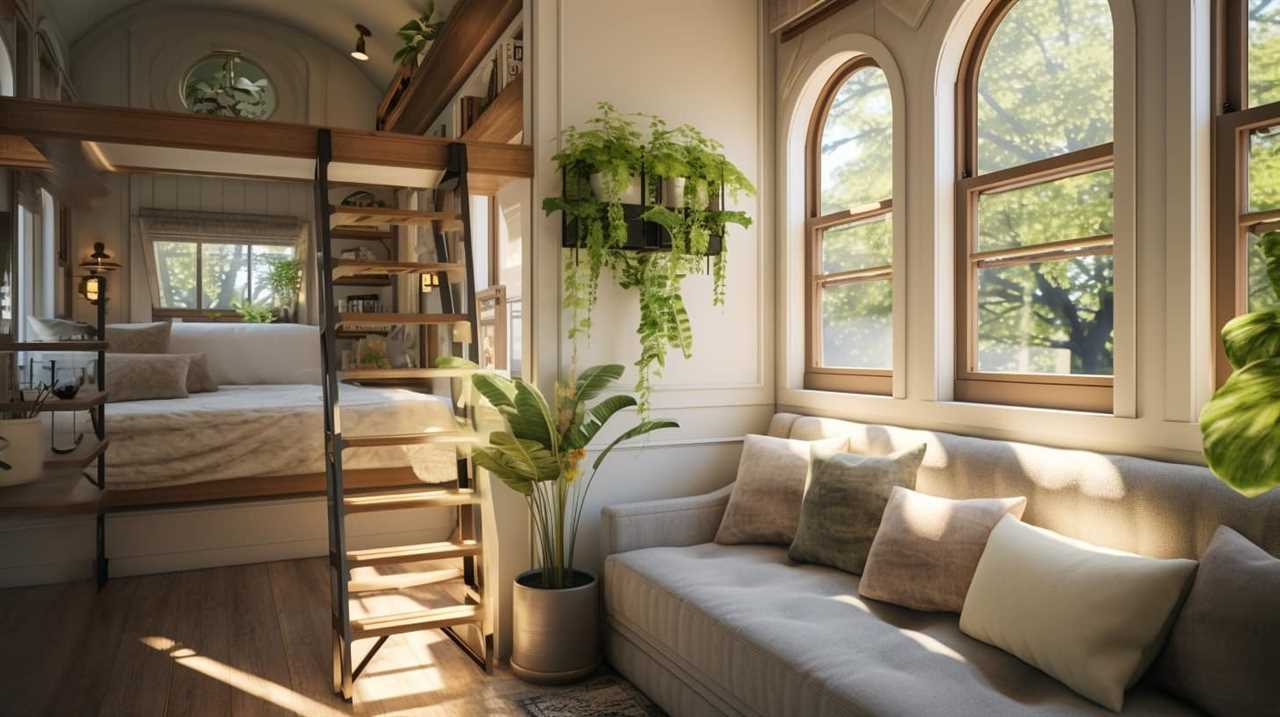
Lastly, implementing greywater recycling methods helps maximize water efficiency by treating and reusing water from sinks, showers, and laundry.
Efficient Fixtures and Appliances
We can save water in our tiny house by installing low-flow fixtures and using efficient appliances. Here are some ways to achieve water conservation in our living space:
-
Energy Efficient Lighting:
-
Install LED lights that use less energy and last longer.

-
Use natural lighting as much as possible to minimize the need for artificial lighting.
-
Install motion sensors or timers to automatically turn off lights when not in use.
-
Water Saving Fixtures:
-
Install low-flow showerheads and faucets that reduce water consumption without sacrificing water pressure.
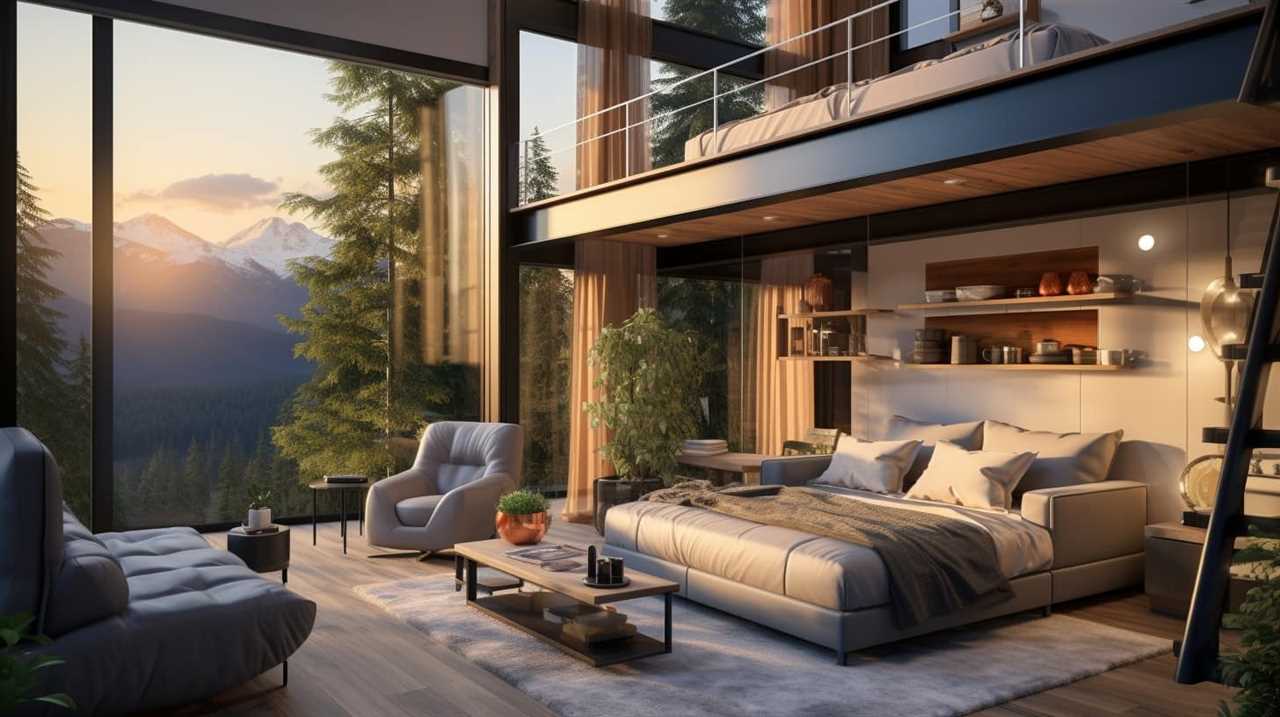
-
Consider dual-flush toilets that have separate buttons for liquid and solid waste, allowing for water-saving options.
-
Efficient Appliances:
-
Choose appliances with high energy and water efficiency ratings, such as Energy Star certified models.
-
Opt for front-loading washing machines that use less water compared to top-loading models.
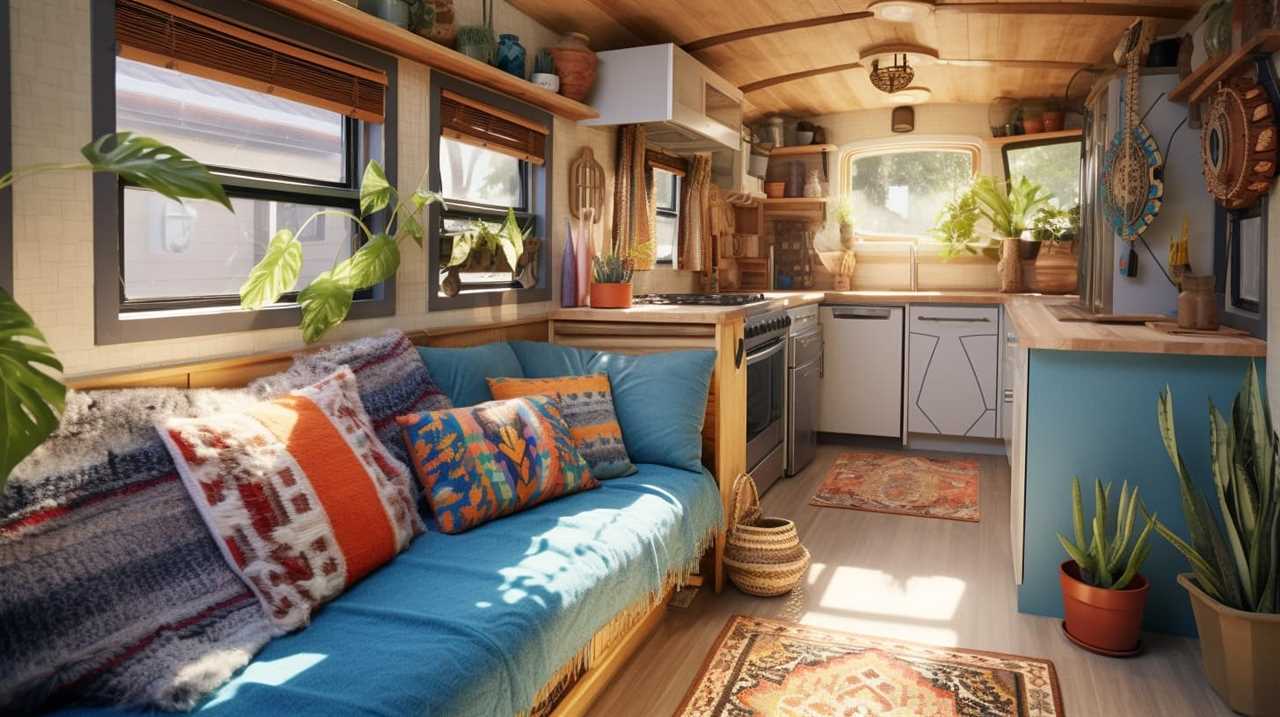
By implementing these strategies, we can’t only conserve water but also reduce our energy consumption, creating a more sustainable and luxurious tiny house living experience.
Now, let’s explore the next section on rainwater harvesting systems.
Rainwater Harvesting Systems
To further enhance our water conservation efforts, we can implement rainwater harvesting systems in our tiny house. This innovative design concept allows us to collect and store rainwater for various uses, reducing our reliance on municipal water sources. By incorporating smart technology integration, we can optimize the efficiency of our rainwater harvesting system. For example, we can use sensors and automated controls to monitor and regulate the collection and distribution of rainwater.
To better understand the benefits of rainwater harvesting systems, let’s take a look at the table below:
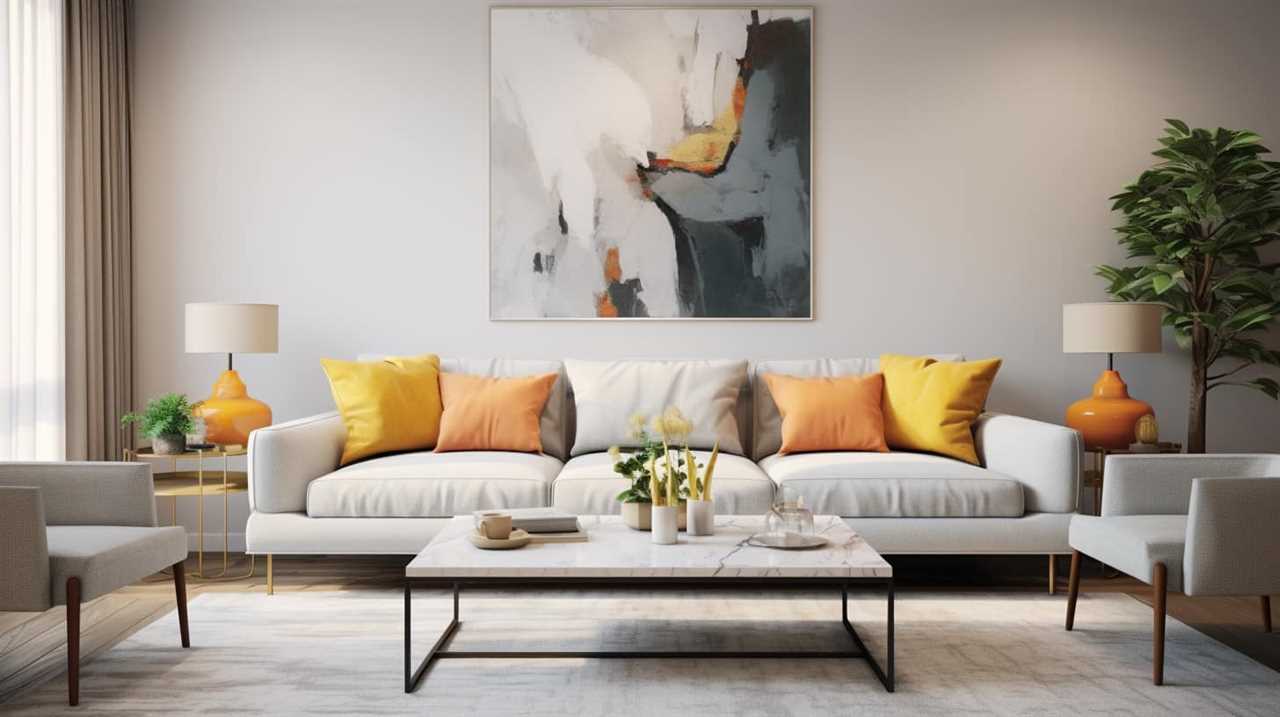
| Benefits | Description |
|---|---|
| Water Conservation | Reduces dependence on municipal water supply and promotes sustainability. |
| Cost Savings | Decreases water bills and minimizes expenses for water usage. |
| Self-Sufficiency | Provides a reliable source of water during droughts or emergencies. |
Greywater Recycling Methods
As we delve into the topic of greywater recycling methods, we can explore various strategies to implement water conservation in our tiny house. By recycling and reusing greywater, we can significantly reduce our water consumption and contribute to a more sustainable lifestyle.
Here are three effective methods to consider:
-
Water filtration options: Installing a greywater filtration system allows you to treat and reuse water from sources like sinks, showers, and laundry. This system removes impurities and contaminants, making the water safe for irrigation purposes.
-
Irrigation methods: Utilizing greywater for irrigation can help nourish your garden while conserving fresh water. Implementing drip irrigation or sub-surface irrigation techniques ensures that water is delivered directly to plant roots, minimizing wastage.
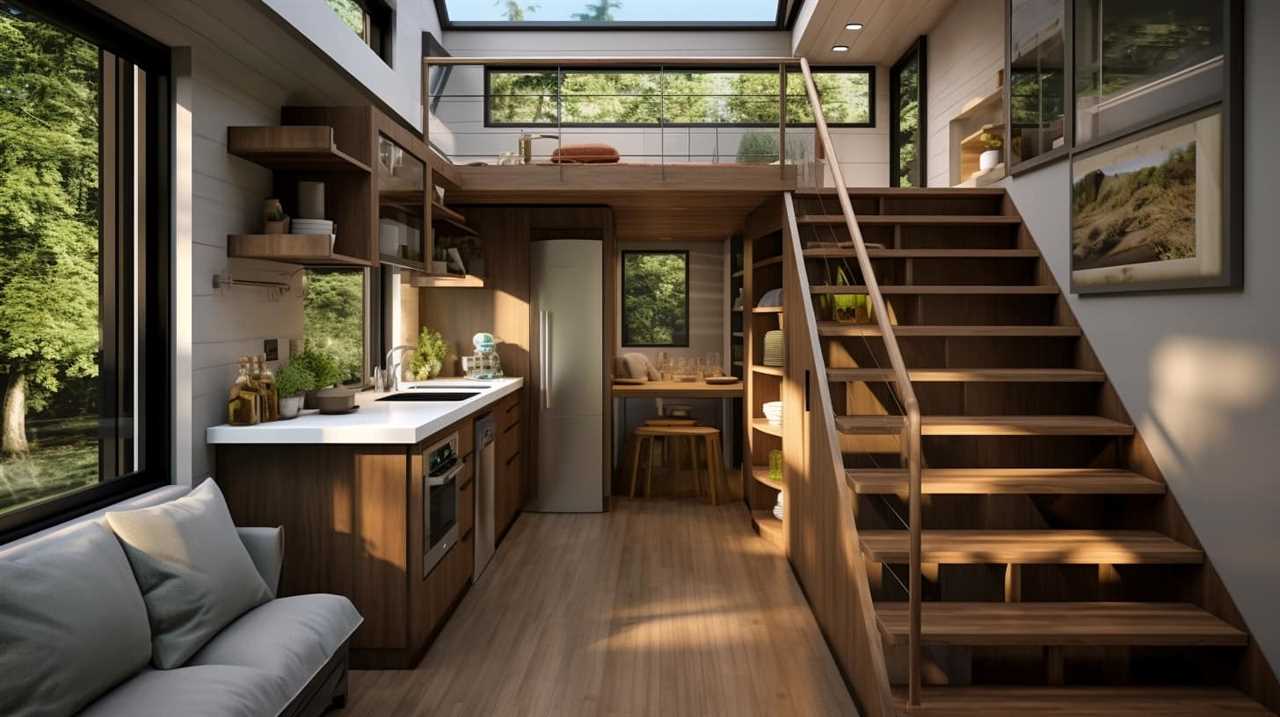
Maximizing Storage Solutions
Organizing and utilizing space efficiently is essential in maximizing storage solutions for tiny house living. In a tiny house, every inch counts, and customized organization is key to keep things tidy and accessible. One way to achieve this is by incorporating hidden storage solutions. These cleverly designed spaces allow you to make the most of every nook and cranny in your tiny home. From hidden compartments under the stairs to built-in storage in furniture pieces, there are endless possibilities to maximize storage while maintaining a sleek and clutter-free aesthetic. Take a look at the table below for some inspiration on how to incorporate hidden storage solutions into your tiny house.
| Storage Solution | Description |
|---|---|
| Under-bed storage | Utilize the space under your bed to store items like clothing or shoes |
| Staircase with built-in drawers | Each step doubles as a drawer, providing ample storage space |
| Fold-out tables | These tables can be folded away when not in use, saving valuable space |
| Wall-mounted shelves | Vertical storage is a great way to utilize empty wall space |
| Hidden cabinets | Install cabinets behind walls or under countertops for hidden storage |
With these creative storage solutions, you can maintain an organized and clutter-free tiny house without sacrificing luxury or style.
Incorporating High-End Finishes and Luxury Features
After carefully considering our budget and timeline, we decided that incorporating high-end finishes and luxury features into our tiny house was the next step in creating our dream home. We wanted to create a space that not only maximized our living area but also exuded elegance and sophistication. To achieve this, we focused on incorporating luxury finishes and high-end features that would enhance the overall aesthetic and functionality of our tiny house.
Here are three key elements we considered:
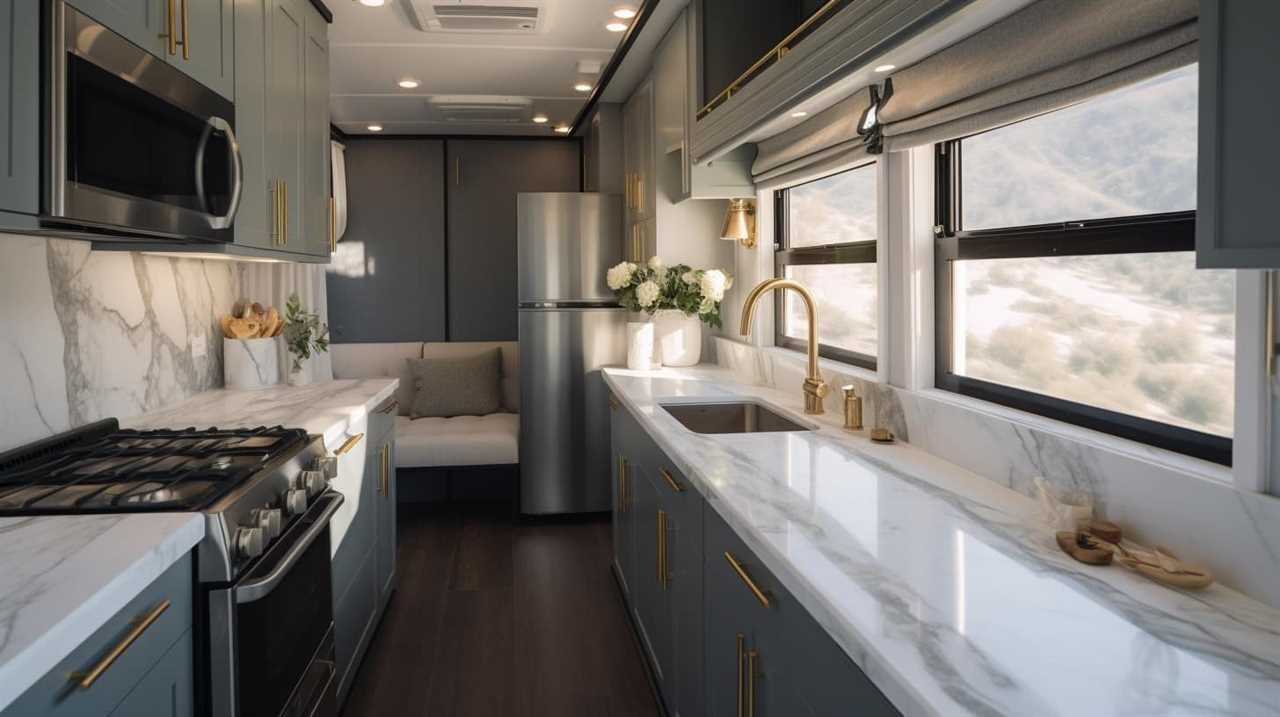
-
Luxury finishes: We opted for premium materials such as marble countertops, hardwood flooring, and designer fixtures to elevate the overall look and feel of our tiny home.
-
High-end features: We invested in state-of-the-art appliances, smart home technology, and custom cabinetry to add convenience and luxury to our living space.
-
Attention to detail: We paid meticulous attention to every aspect of our tiny house, from the choice of lighting fixtures to the selection of high-quality upholstery and accessories, ensuring a cohesive and luxurious design.
Creating a Lush and Eco-Friendly Outdoor Space
We can create a lush and eco-friendly outdoor space for our tiny house by incorporating sustainable landscaping and utilizing recycled materials. Sustainable gardening practices, such as composting, rainwater harvesting, and using native plants, can help minimize our impact on the environment while still creating a beautiful outdoor oasis. Consider installing a rooftop garden to maximize space and promote biodiversity. These gardens not only provide a green and serene retreat but also help insulate the house, reducing energy consumption.

When it comes to materials, opt for recycled and repurposed elements like reclaimed wood for decks and furniture, or recycled glass for decorative accents. By embracing sustainable gardening and utilizing recycled materials, we can transform our outdoor spaces into eco-friendly havens that enhance our tiny house living experience.
Speaking of embracing sustainability, another important aspect is embracing minimalism and decluttering techniques.
Embracing Minimalism and Decluttering Techniques
By prioritizing functionality and removing unnecessary belongings, we can create a sense of spaciousness and tranquility in our tiny house living. Embracing a minimalist lifestyle and implementing effective organizing techniques can greatly enhance our living experience.
Here are three key strategies to help us achieve minimalism and declutter our tiny homes:
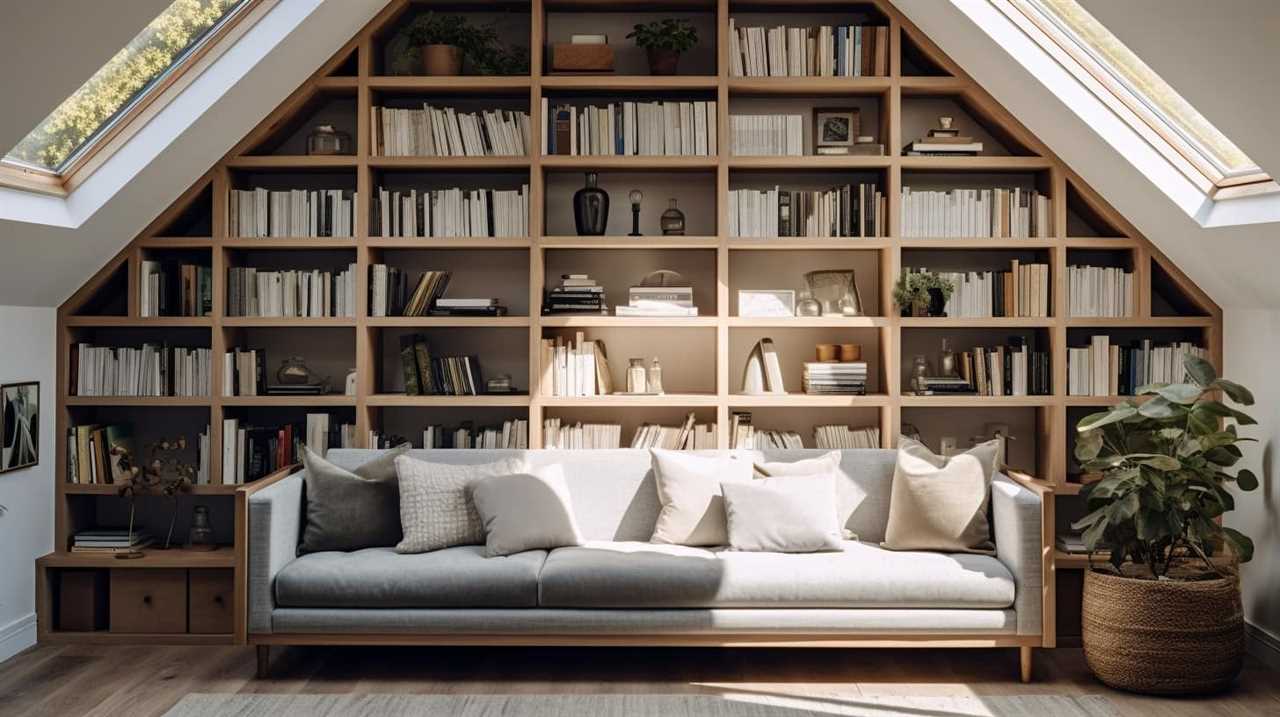
-
Simplify your belongings: Assess each item and ask yourself if it serves a purpose or brings you joy. Let go of things that no longer serve you and only keep what’s essential.
-
Optimize storage solutions: Maximize the use of vertical space, invest in multi-functional furniture, and utilize underutilized areas such as walls and ceilings to create storage solutions.
-
Develop a cleaning routine: Regularly declutter and clean your space to maintain order and prevent clutter from accumulating.
Maintaining and Sustaining Your Tiny House for Long-Term Luxury Living
To ensure the long-term luxury of our tiny house, we must regularly maintain and sustain it. Long-term maintenance is essential for keeping our tiny house in optimal condition and preserving its value.
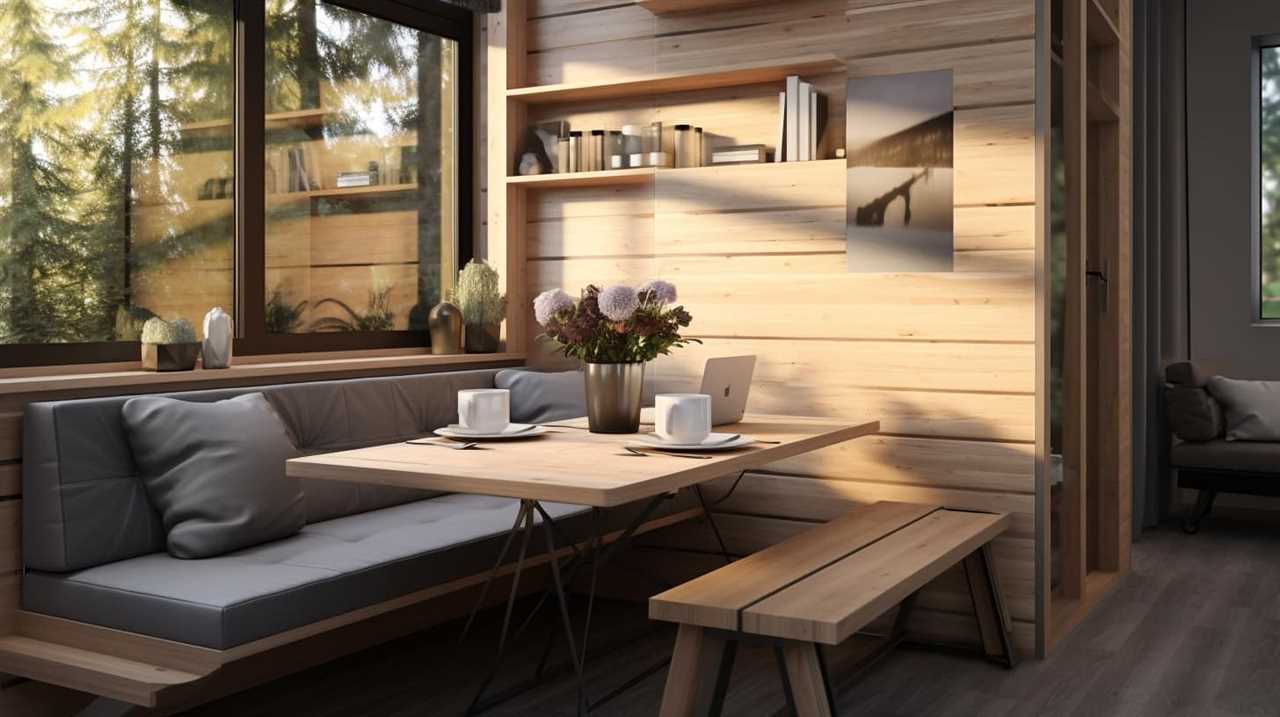
One important aspect of long-term maintenance is using sustainable materials throughout the construction and design process. Choosing eco-friendly materials not only reduces our environmental impact but also ensures the durability and longevity of our tiny house. For example, using reclaimed wood for flooring or countertops adds a unique touch while minimizing waste.
Additionally, regular inspections and repairs are necessary to catch any potential issues before they become major problems. This includes checking for leaks, inspecting the electrical system, and maintaining the plumbing.
Frequently Asked Questions
How Much Does It Cost to Build a Tiny House?
Cost considerations and budget planning are crucial when building a tiny house. It’s important to research materials, labor costs, and permits. With careful planning and smart choices, we can achieve sustainability and luxury in tiny house living.
What Are the Legal Requirements for Living in a Tiny House?
Understanding zoning regulations and insurance requirements are important for living in a tiny house. We researched and found that each city has its own rules, so it’s essential to consult local authorities to ensure compliance.
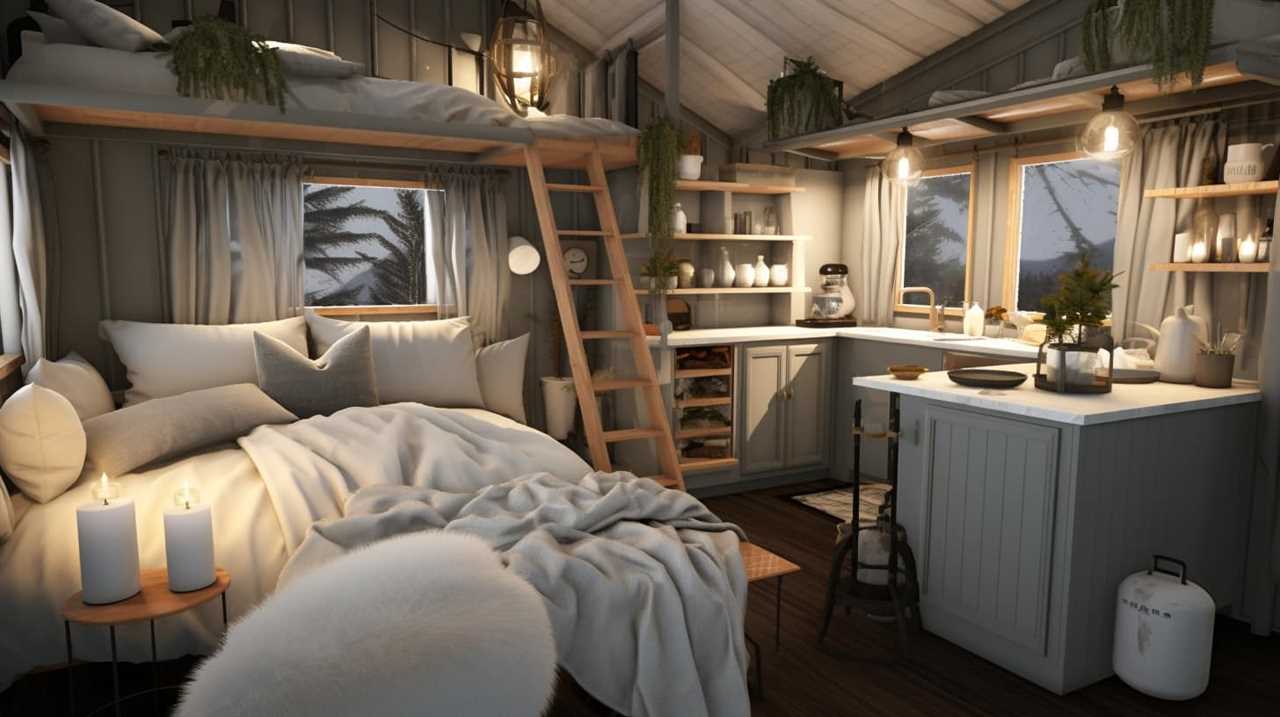
Are There Any Financing Options Available for Building a Tiny House?
Financing options for building a tiny house can include personal savings, loans, or crowdfunding. Research local banks and credit unions for potential loans. Consider using sustainable building materials to align with sustainability goals.
How Long Does It Take to Build a Tiny House?
Building a tiny house can take anywhere from a few weeks to several months, depending on the complexity and size of the project. The construction process involves various steps, such as planning, designing, obtaining permits, and executing the build.
Can You Live in a Tiny House With a Family?
Living in a tiny house with a family offers numerous benefits, such as fostering a sense of togetherness and reducing environmental impact. However, challenges of raising children in a small space must be considered.
Conclusion
In conclusion, achieving sustainability and luxury in tiny house living requires careful consideration and planning.
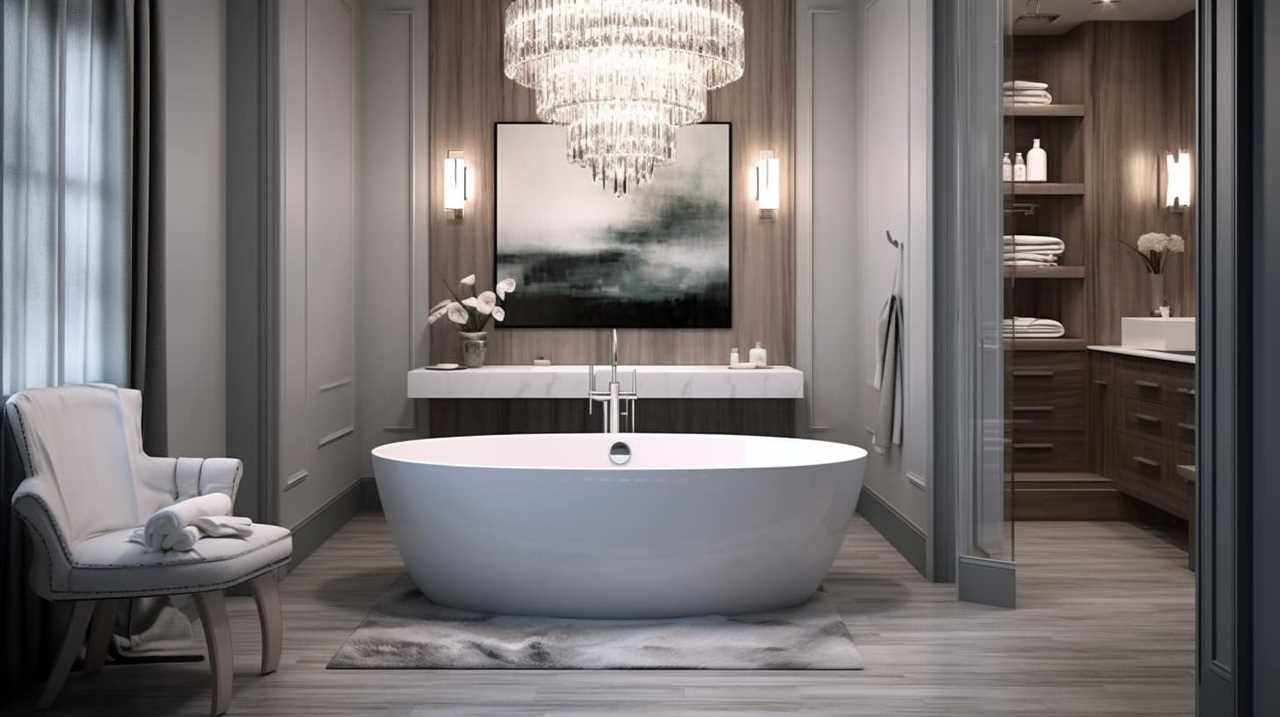
By choosing the right location, designing an efficient floor plan, incorporating sustainable materials, and harnessing renewable energy sources, you can create a luxurious and eco-friendly home.
Embracing water conservation strategies, high-end finishes, and creating a lush outdoor space will further enhance the luxury experience.
Remember, maintaining and sustaining your tiny house is essential for long-term luxury living.
So, why not start your journey towards sustainable luxury today?

I’m Theodore, and I love tiny houses. In fact, I’m the author of Tiny House 43, a book about tiny houses that are also tree houses. I think they’re magical places where imaginations can run wild and adventures are just waiting to happen.
While tree houses are often associated with childhood, they can be the perfect adult retreat. They offer a cozy space to relax and unwind, surrounded by nature. And since they’re typically built on stilts or raised platforms, they offer stunning views that traditional homes simply can’t match.
If you’re looking for a unique and romantic getaway, a tree house tiny house might just be the perfect option.






